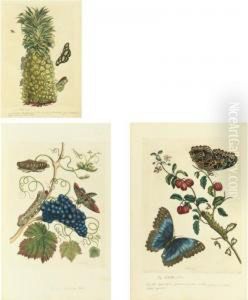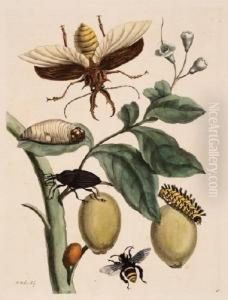Maria Merian Paintings
Maria Sibylla Merian was a German-born naturalist and scientific illustrator who made significant contributions to the field of entomology and botanical art. Born on April 2, 1647, in Frankfurt am Main, Holy Roman Empire, she was the daughter of the Swiss engraver and publisher Matthäus Merian the Elder, and his second wife, Johanna Sibylla Heim. Following her father's death when she was just three years old, her mother remarried to still-life painter Jacob Marrel, who introduced Maria to the world of painting and illustration.
Merian's artistic talents became evident at an early age, and she developed a keen interest in insects and plants, which became the subjects of her detailed paintings. At the age of 18, she married Johann Andreas Graff, a fellow artist, with whom she had two daughters. During her marriage, she continued to pursue her interests in art and science, publishing her first book of natural illustrations, 'Neues Blumenbuch', in 1675.
Maria's fascination with insect metamorphosis, which was poorly understood at the time, led her to conduct extensive observations. In 1679, she published 'Der Raupen wunderbare Verwandlung und sonderbare Blumennahrung' (The Caterpillar's Marvelous Transformation and Strange Floral Food), a book that combined her detailed observations with intricate illustrations of the life cycles of butterflies and moths. This work was revolutionary as it contradicted the contemporary belief that insects spontaneously generated from mud.
In 1691, Merian moved with her mother and daughters to the Labadist community in Wieuwerd, in the Dutch Republic, where she continued her studies and illustrations. After her mother's death, she settled in Amsterdam in 1699, which was a center for scientific inquiry and publishing. Her work caught the attention of the city's scientific community and collectors, and she gained access to exotic plants and insects collected from Dutch colonies.
Merian's most ambitious work was inspired by the exotic specimens she saw in Amsterdam. At the age of 52, she embarked on a pioneering expedition to Suriname, a Dutch colony in South America, with her younger daughter Dorothea. There, she studied and recorded the indigenous flora and fauna. In 1705, after two years of research and despite health issues and financial difficulties, she published 'Metamorphosis insectorum Surinamensium' (Metamorphosis of the Insects of Suriname), which brought her international acclaim.
Maria Sibylla Merian passed away on January 13, 1717, in Amsterdam. Her work has left a lasting legacy, combining scientific accuracy with artistic beauty, and she is often considered one of the most important contributors to the field of entomology. Her illustrations provided the basis for future studies and are still admired for their detail and precision. Merian's life and work have inspired generations of artists and scientists, and she is recognized as one of the first to observe and depict insects in their natural habitat through their life cycles.

